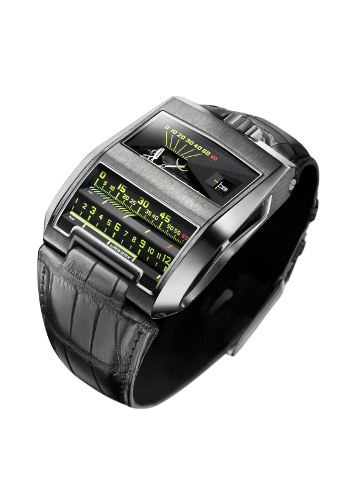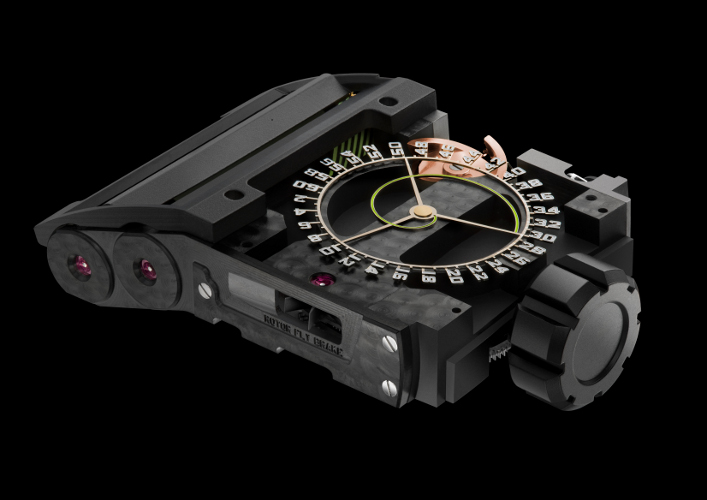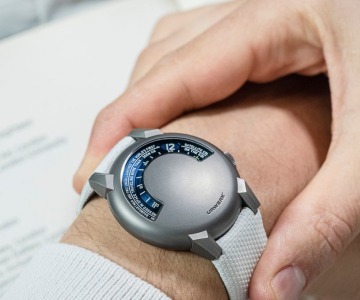 La lecture du temps nous est souvent – très souvent – proposée sous forme circulaire. Un cadran, deux voire trois aiguilles, et le temps s’égrène dans une ronde perpétuelle. Pourtant cette conception du temps est à l’encontre de ce que l’on nous apprend sur les bancs de l’école : tirer une longue ligne sur la page blanche, marquer ses repères, Passé, Présent, Futur. Pourquoi cette différence ? Avant tout pour des raisons techniques. Mettre au point le mécanisme qui transcrit le temps tel que nous le pensons n’est pas mince affaire. URWERK s’y essaie avec succès et avec la UR-CC1 met en scène le temps linéaire.
La lecture du temps nous est souvent – très souvent – proposée sous forme circulaire. Un cadran, deux voire trois aiguilles, et le temps s’égrène dans une ronde perpétuelle. Pourtant cette conception du temps est à l’encontre de ce que l’on nous apprend sur les bancs de l’école : tirer une longue ligne sur la page blanche, marquer ses repères, Passé, Présent, Futur. Pourquoi cette différence ? Avant tout pour des raisons techniques. Mettre au point le mécanisme qui transcrit le temps tel que nous le pensons n’est pas mince affaire. URWERK s’y essaie avec succès et avec la UR-CC1 met en scène le temps linéaire.
Linéaire. Sur la UR-CC1, deux lignes horizontales. Deux cylindres – l’un pour les heures, l’autre pour les minutes. Ne vous méprenez pas sur l’apparente simplicité d’un tel affichage. Il a requis plus de trois ans de développement et nécessitera trois années de production. Toute la difficulté, mouvoir ces deux cylindres – 2 mastodontes – de façon isochrone.
Triple came. Une triple came verticale et un segment denté (visibles sur la tranche de la UR-CC1) assurent la rotation du cylindre des minutes. Le cylindre des minutes effectue une rotation de 300° de zéro à soixante minutes. Arrivé au marqueur des 60 minutes, le cylindre est ramené à sa position d’origine en 1/10ème de seconde par un fin ressort extra-plat. Ce mouvement rétrograde des minutes provoque l’avancée du cylindre des heures d’une unité.
La triple came est réalisée en bronze béryllium, un métal connu pour ses propriétés autolubrifiantes et son faible coefficient de friction. Elle prend la forme de trois mini-triangles à pente aigue. Cette triple came assure la trajectoire du segment denté relié au cylindre des minutes. La tripe came effectue une rotation complète en trois heures, chaque came permettant la rotation du cylindre des minutes du marqueur 0 à 60minutes. Cent quatre points de référence ont été calculés pour déterminer l’angle parfait de chacune des trois cames.
(Second’s wheel : disque des secondes / tripe-cam : triple came / rack : segment denté)
Segment denté: le segment denté relie la came au cylindre des minutes. Il présente deux propriétés à première vue contradictoire. Il se doit d’être parfaitement rigide afin de transmettre fidèlement le mouvement de la triple came au cylindre des minutes et extrêmement léger afin de consommer le minimum d’énergie possible. Cette pièce sensible a été exécutée par la maison Mimotec grâce à son tout nouveau procédé de photolithographie. Elle présente une structure en nid d’abeille lui permettant de réunir les deux conditions à première vue contradictoire dureté et extrême légèreté.
Disque de la seconde : le cadran de la UR-CC1 est animé, en première mondiale, d’une seconde digitale. Elle affiche les chiffres pairs des secondes. Pour réaliser cet exploit technique, la pièce a été usinée grâce au procédé de photolithographie, un procédé encore plus précis que l’électro-érosion. Pour rendre la pièce encore plus légère, chaque marqueur des secondes a été squeletté. Le logo URWERK, qui apparaît en face du chiffre 10, joue son rôle de contrepoids pour assurer un équilibre parfait de cette petite merveille de précision qui affiche un poids de 0.09 grammes !
Rotor fly brake : La UR-CC1 bénéficie de la technique de frein pneumatique du « rotor fly brake », une hélice reliée au rotor de la montre. Ce système protège le système de remontage automatique des chocs trop violents et assure une meilleure longévité de la pièce. Le « rotor fly brake » est apparent sur le flanc de la UR-CC1.
Spécifications techniques:
Modèle: UR-CC1
Boîtier: disponible en or gris avec fonds en titane (production limitée de 25pièces) et en or “noir” avec fonds en titane (production limitée de 25 pièces) ; finition poli satiné.
Mouvement: calibre UR-CC1; remontage automatique régulé par frein pneumatique « fly brake turbine »
Indications: Heures et minutes à lecture linéaire avec heures sautantes et minutes rétrogrades ; double affichages des secondes digitale et linéaire
Cadran et ponts: ARCAP P40. Traitement SuperLumiNova sur les marqueurs des heures et des minutes
 Time is usually – nearly always – displayed by a circular indication: one dial and two (or three) with the time displayed around a perpetual circle. However, this 360° representation of time goes against everything we learnt as we grew up drawing a straight line on a blank page and marking it Past, Present and Future. Why do we think of time as travelling in a straight line yet display it rotating around a circle? The answer is straightforward: mechanisms that continually rotate are much simpler to produce than those that trace a straight line then return to zero. In fact, the latter is so difficult that, until now, nobody has ever managed to develop a production wristwatch with true retrograde linear displays.
Time is usually – nearly always – displayed by a circular indication: one dial and two (or three) with the time displayed around a perpetual circle. However, this 360° representation of time goes against everything we learnt as we grew up drawing a straight line on a blank page and marking it Past, Present and Future. Why do we think of time as travelling in a straight line yet display it rotating around a circle? The answer is straightforward: mechanisms that continually rotate are much simpler to produce than those that trace a straight line then return to zero. In fact, the latter is so difficult that, until now, nobody has ever managed to develop a production wristwatch with true retrograde linear displays.
Linear. On the UR-CC1, there are two horizontal indications displayed by two cylinders: one for the (jumping) hours, the other for the retrograde minutes. And don’t be lulled by the apparent simplicity of the displays; the UR-CC1 is the result of more than three years of research, development, production and testing to ensure that the rotation and instant fly-back of the large hour and minute cylinders was achieved without compromising accurate timekeeping.
Triple-cam. A vertical triple-cam operating a toothed rack (visible through a window in the side of the case) rotates the minute cylinder. From zero to sixty minutes, the minute cylinder rotates through 300°. On arriving at the 60-minute mark the cylinder instantly (1/10th of a second) reverses back to its original position thanks to an extra-flat linear spring. The retrograde movement of the minute cylinder triggers the hour cylinder to advance (jump) one complete hour.
The triple-cam is crafted from bronze beryllium, a metal selected for its inherently self-lubricating properties and low co-efficient of friction, and takes the form of three small inclines. The precise shape of the curve of the incline is relayed to the pivoting rack, while the teeth on the end of the rack mesh with and rotate the minute cylinder. The triple-cam makes a complete rotation in three hours so that each of the three inclines takes 60 minutes, and 180 points of reference have been calculated on each of the three cams to ensure the precise and isochronic rotation of the minute cylinder.
Toothed segment: The toothed segment at the end of the rack transmits and transforms the rotation of the triple-cam into the rotation of the minute cylinder. The toothed rack presents two properties that at first appear contradictory: absolute rigidity, so as to accurately transmit the motion of the cam to the minute cylinder; and extremely low mass to consume as little energy as possible and minimise the effects of gravity and accelerations/shocks. This vital component has been fabricated by Mimotec using their photolithography process. The honeycomb pattern of the structure resolves the two apparently contradictory requirements of maximum strength and minimum weight.
Seconds disk: The dial of the UR-CC1 is animated by a rotating disk displaying the seconds both digitally and linearly – a world first! This incredible exploit was achieved thanks to Mimotec’s photolithography production technique; the procedure is even more precise than electro-erosion. To reduce mass to an absolute minimum, the minuscule numerals were even skeletonised. A small tab at 10 seconds bearing the URWERK logo precisely counterbalances the disk’s single-digit numbers. This marvel of micro-precision weighs only 0.09 grams.
Rotor Fly Brake: UR-CC1 features URWERK’s pneumatic shock-absorbing Rotor Fly Brake automatic winding system, which minimizes rotor and mechanism wear and damage from shock and harsh movements. The operation of the Rotor Fly Brake is visible through a window on the side of the case.
Technical Specifications:
Model: UR-CC1
Case: available in either white gold with titanium case back (limited edition of 25 pieces) or black gold with titanium case back (limited edition of 25 pieces); brushed-satin finish
Movement: calibre UR-CC1; automatic winding regulated by “fly brake turbine” pneumatic shock absorber
Indications: linear display for hours and minutes with jumping hours and retrograde minutes ; second display both digital and linear
Dimensions: 42.6mm x 53mm x 18mm
Dial and Bridges: ARCAP P40. SuperLumiNova treatment on hours, minutes displays

